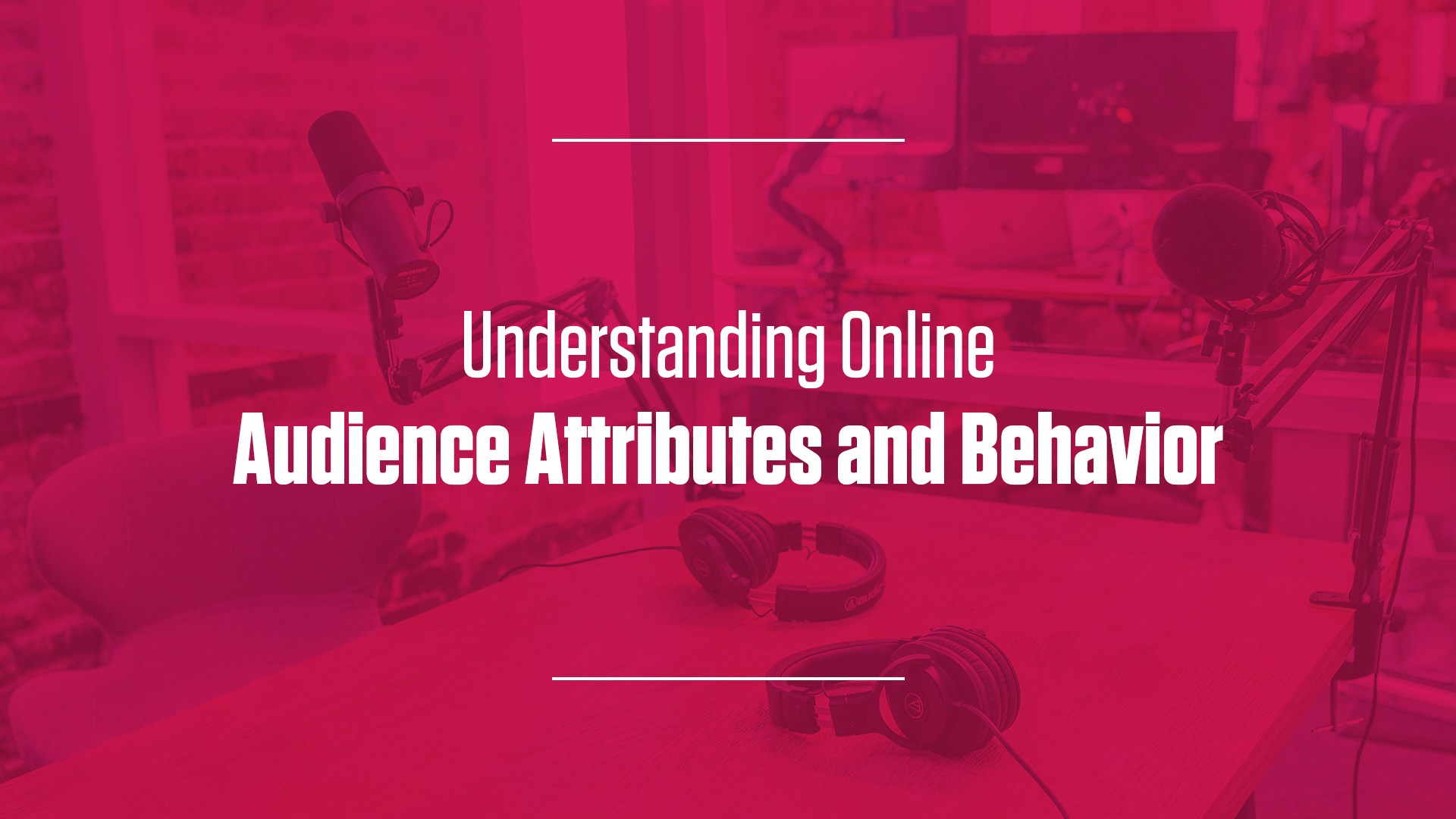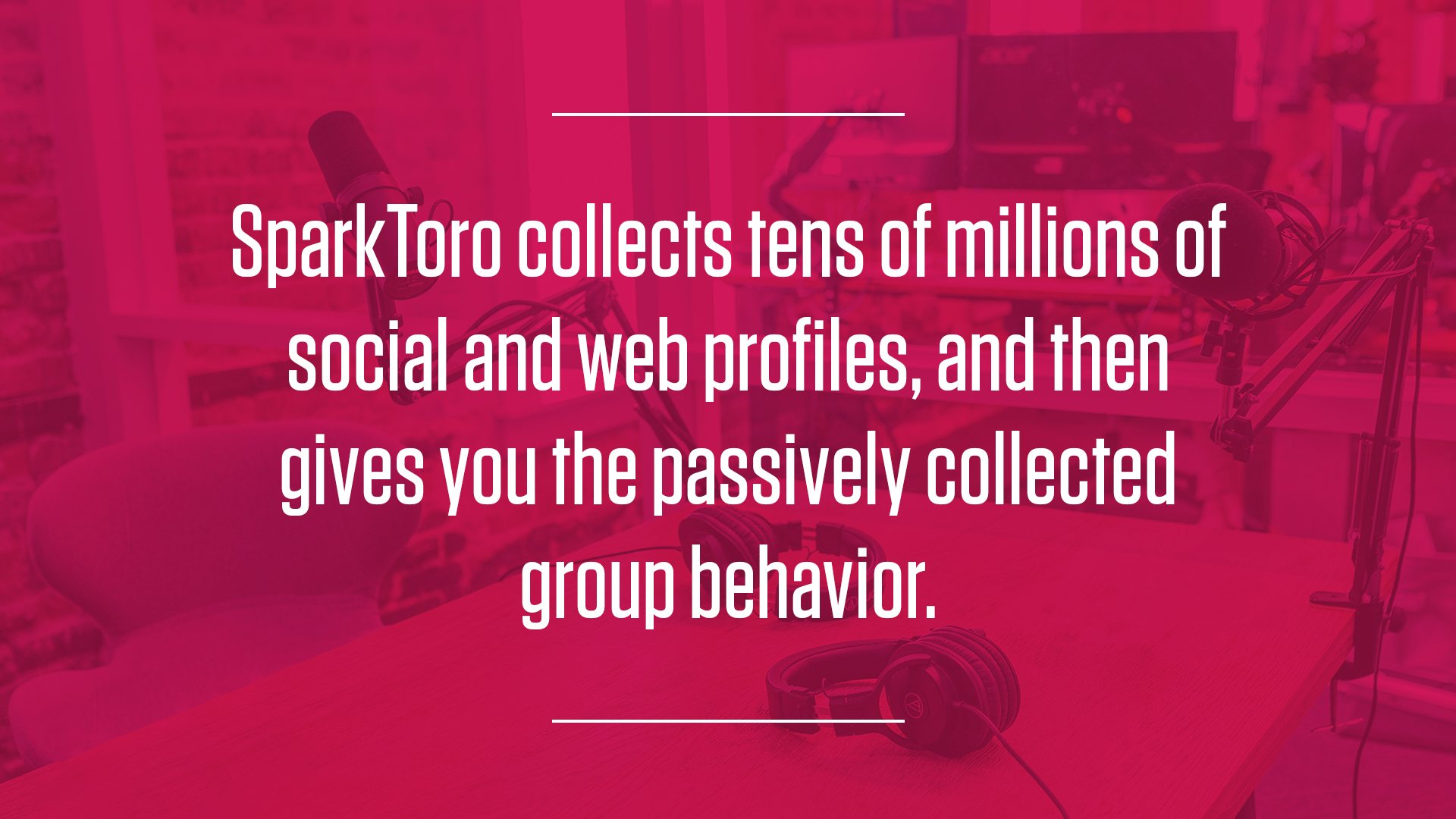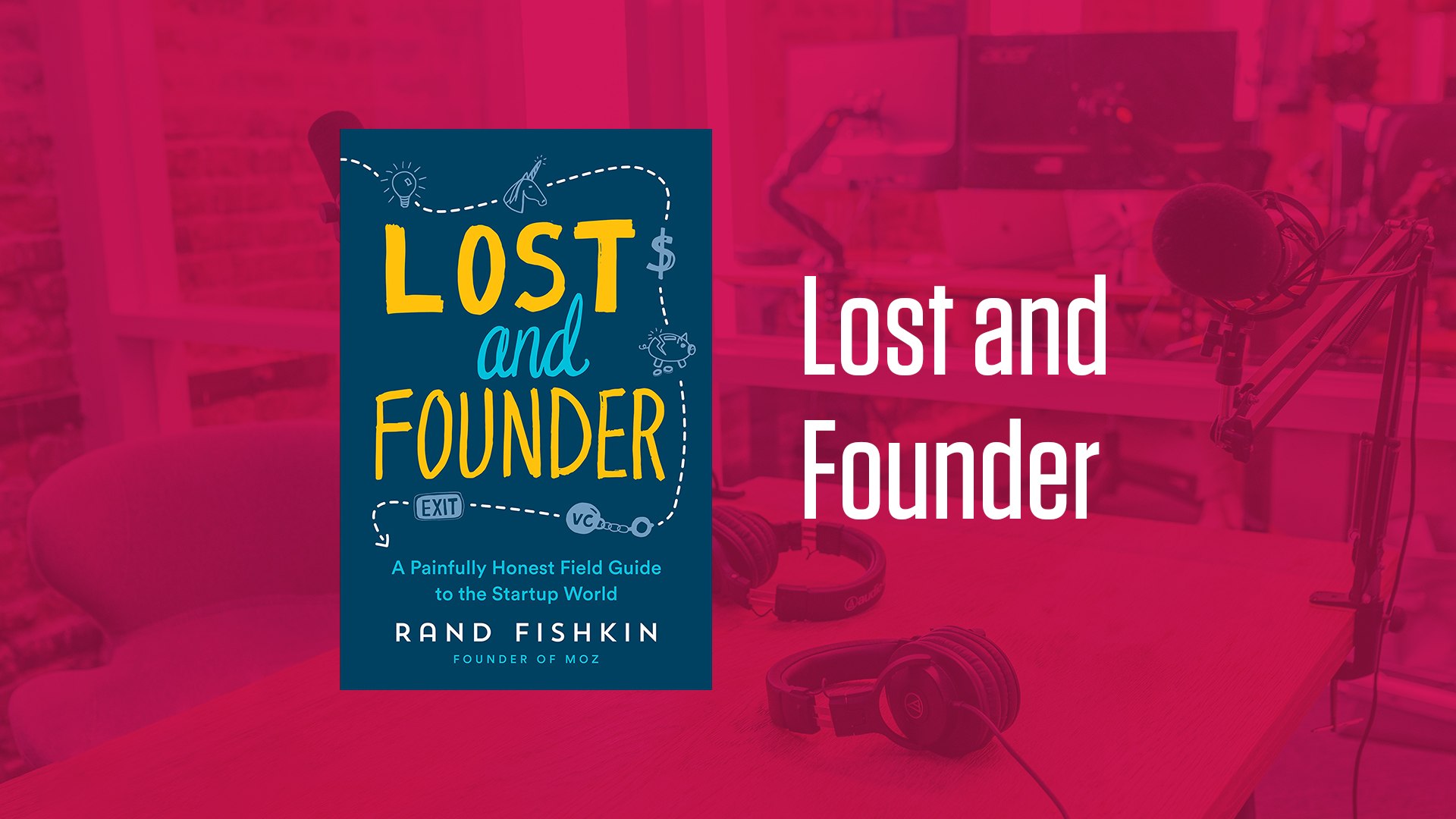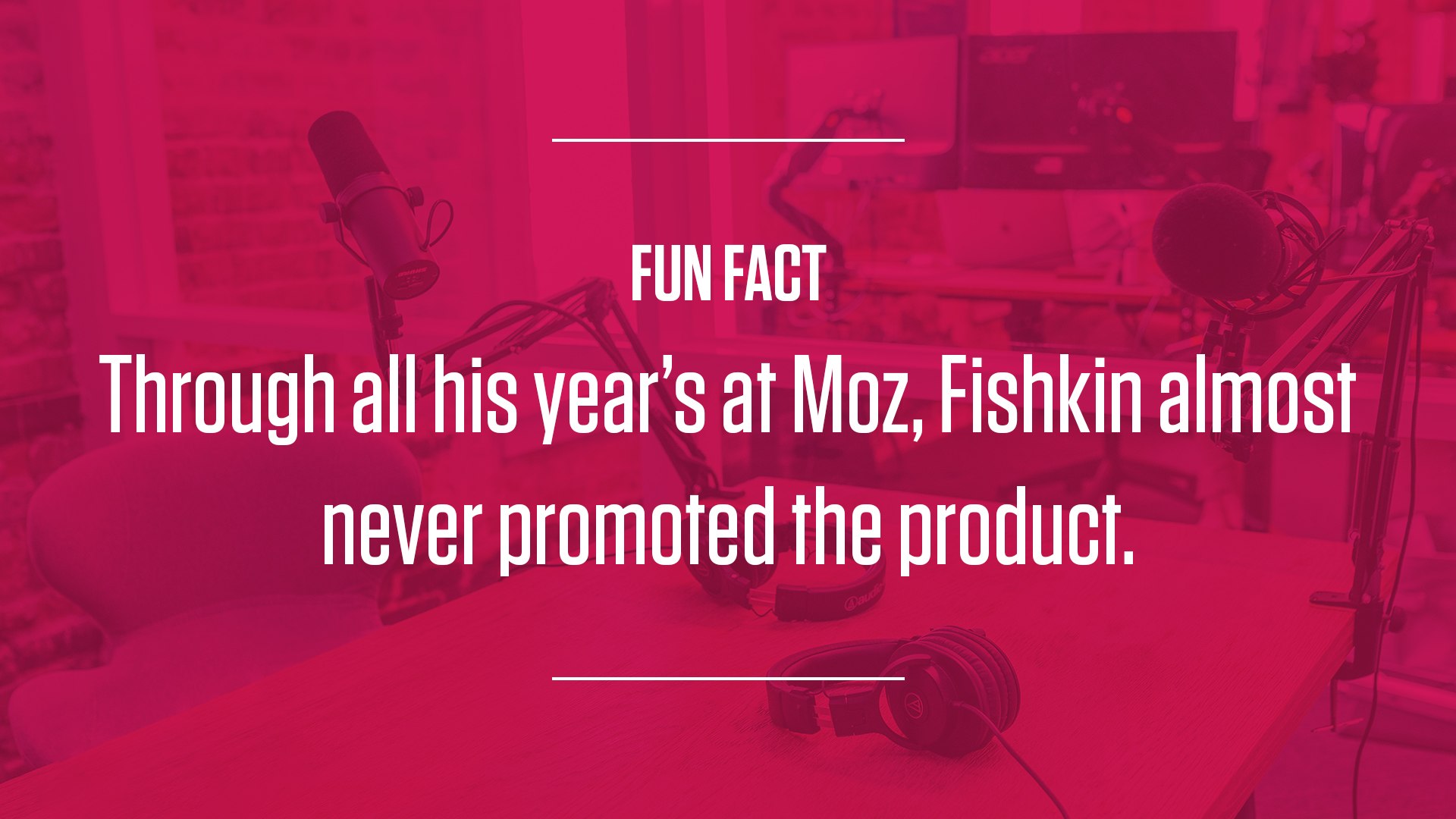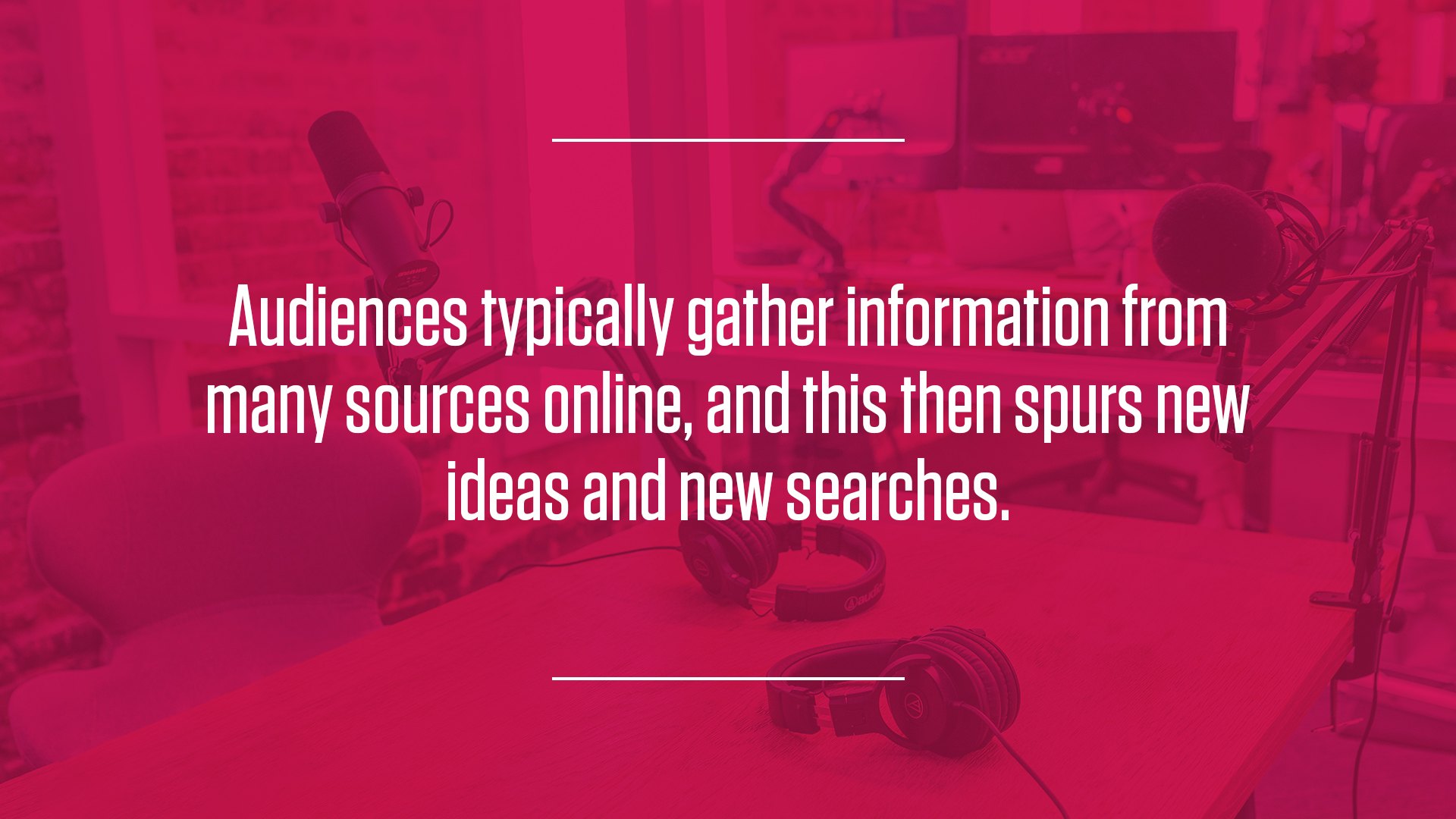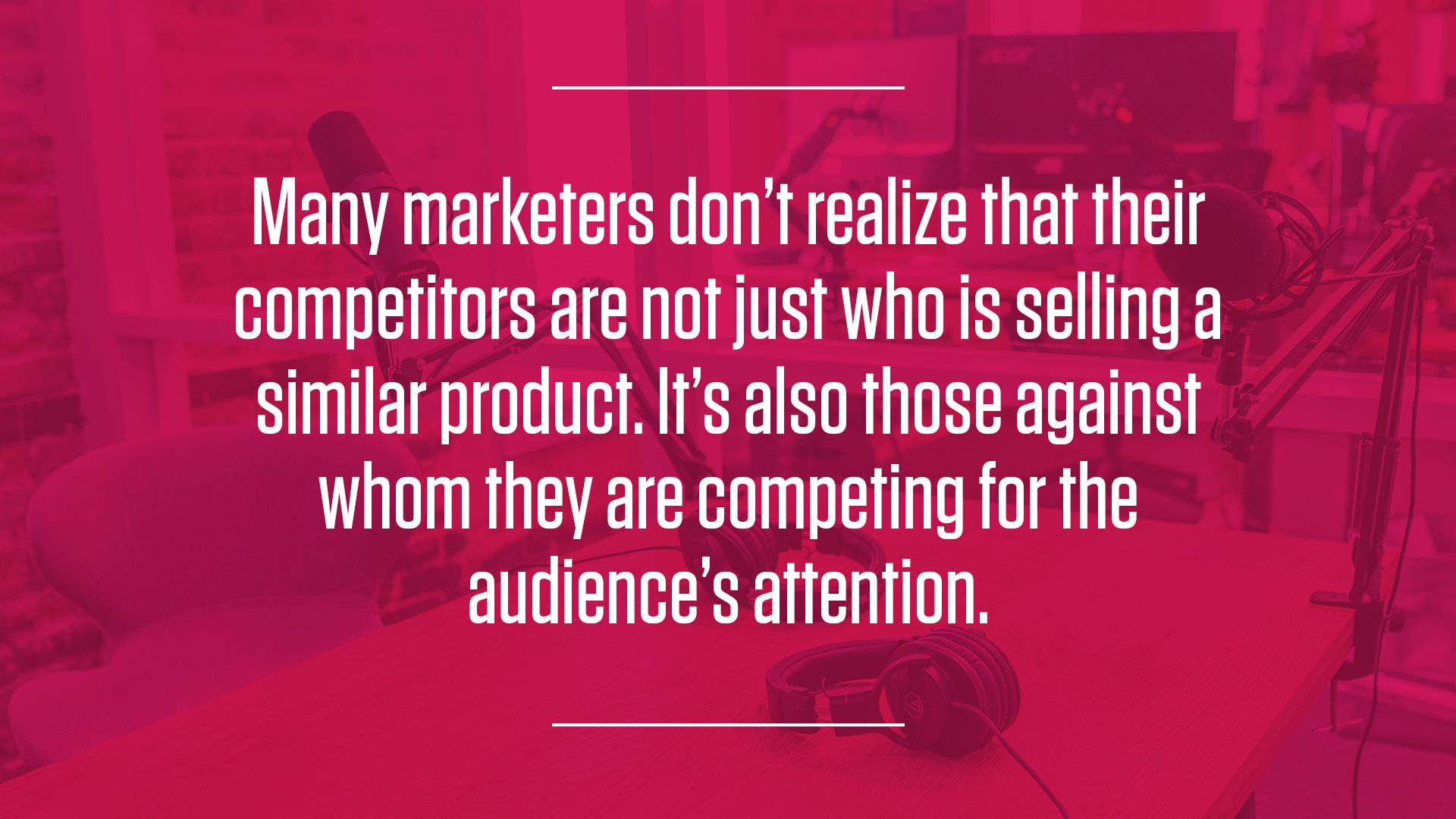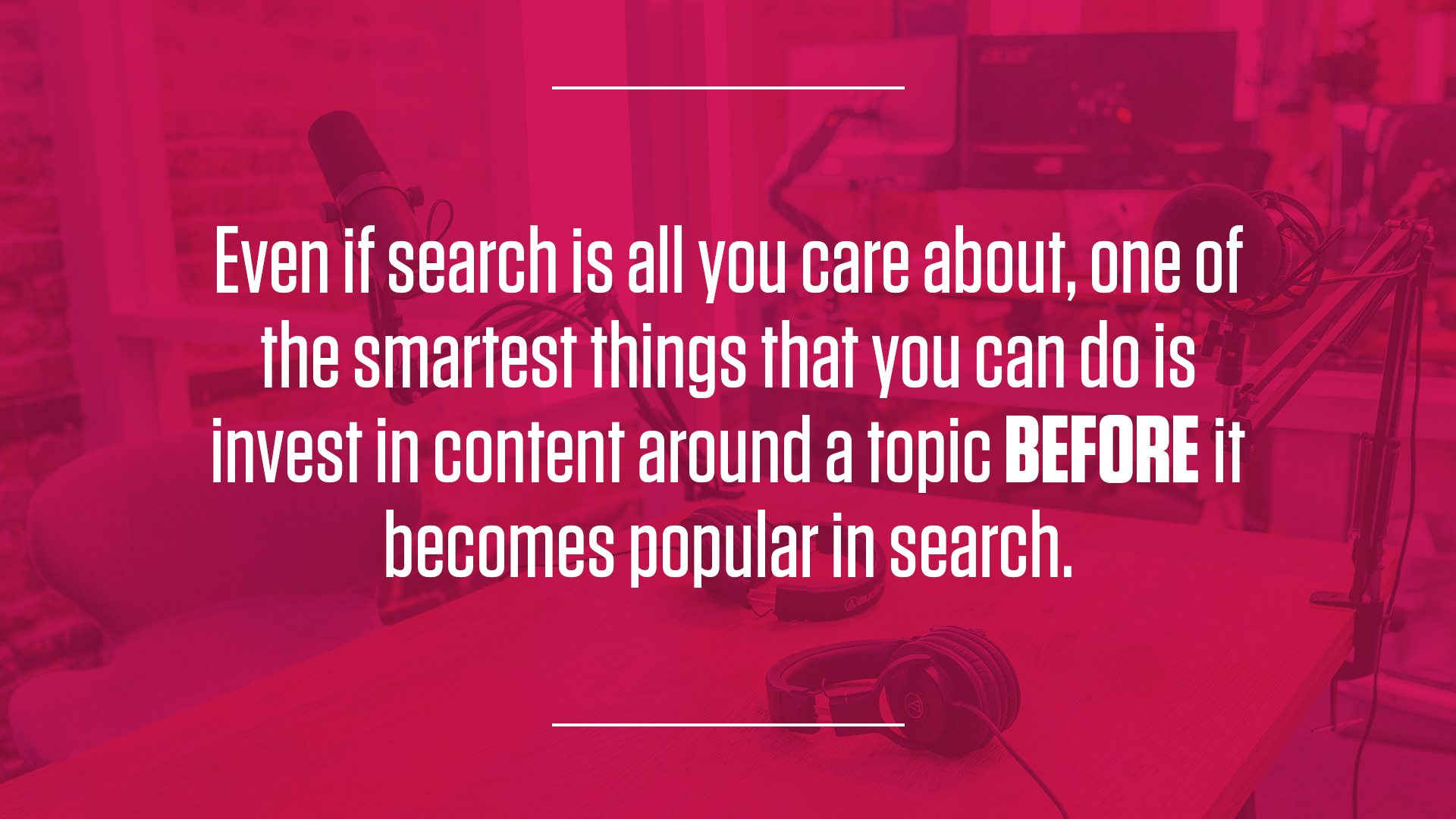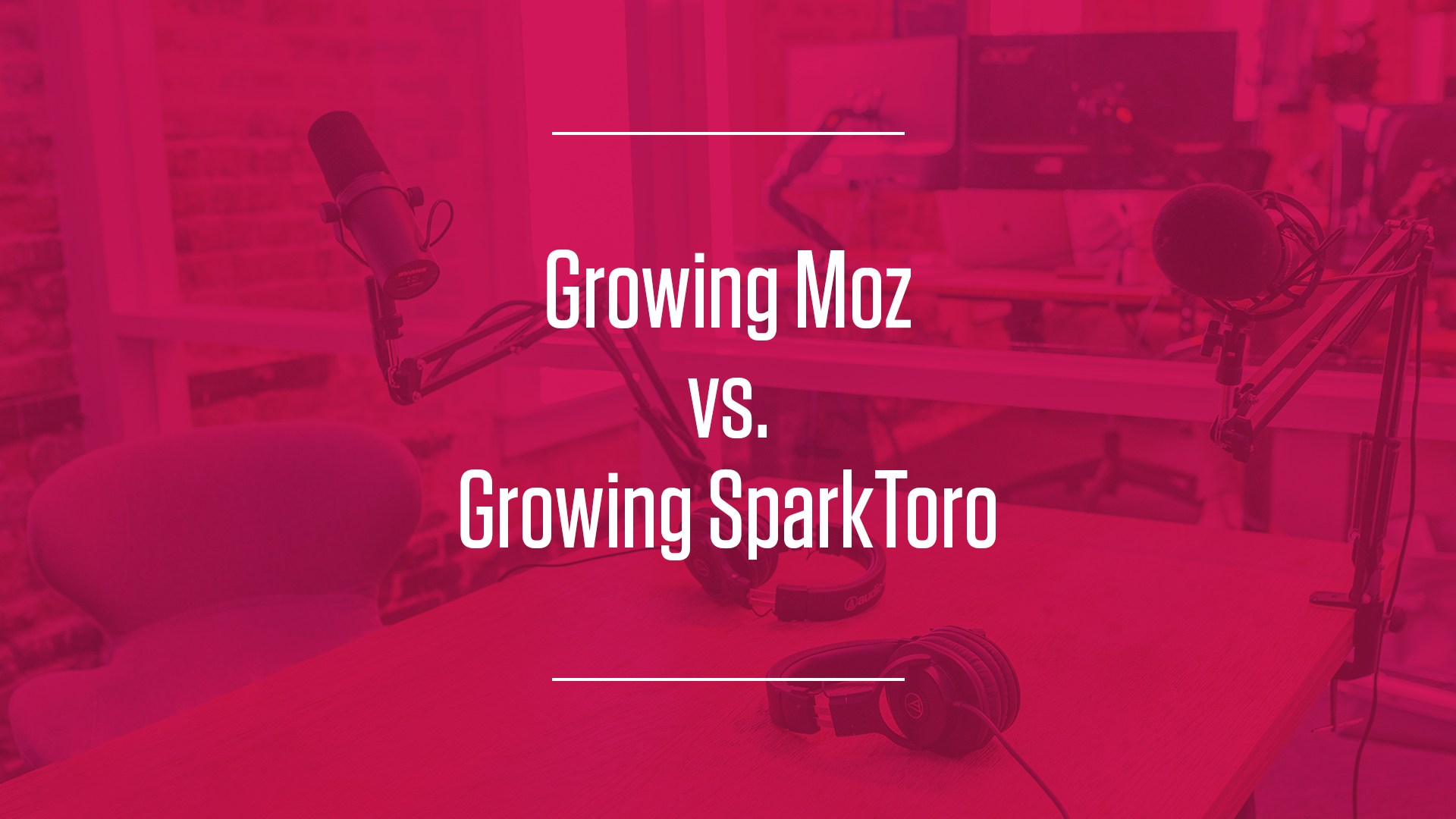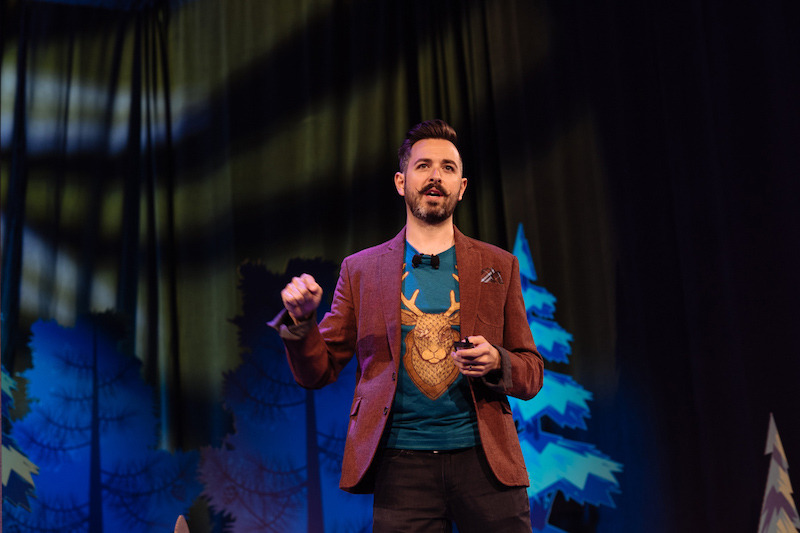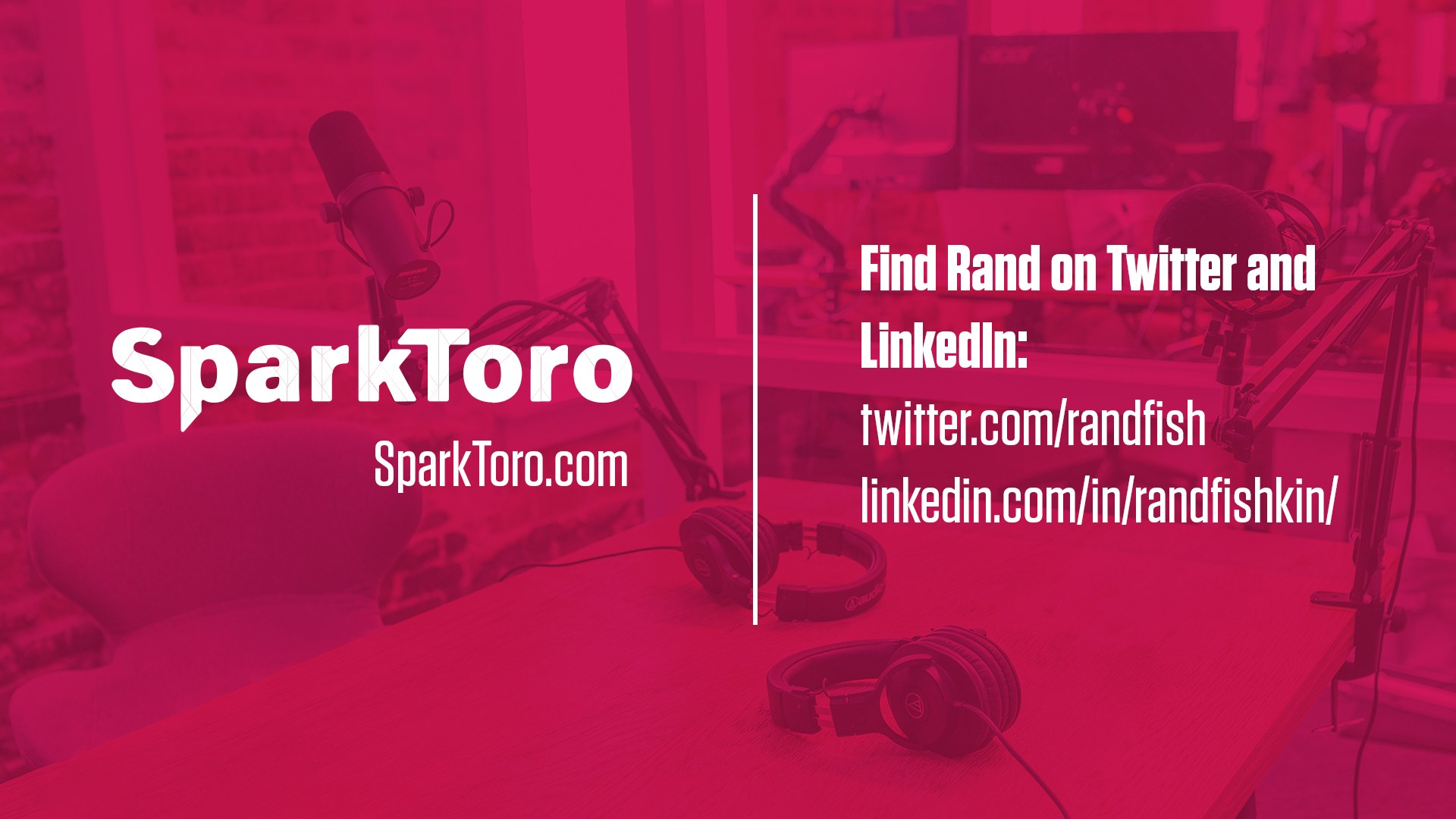Deeper Audience Intelligence with SparkToro’s Rand Fishkin
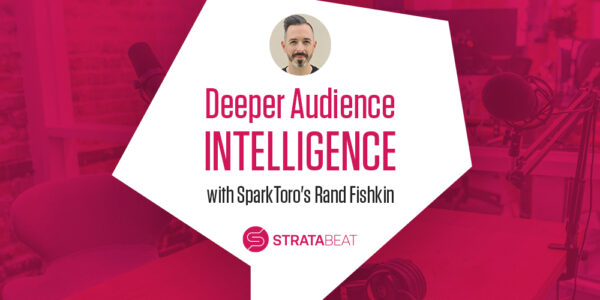
Stratabeat had the privilege of interviewing Rand Fishkin, Cofounder and CEO of SparkToro, on the latest episode of B2B Marketing Tech Talks.
SparkToro is an audience research software startup. SparkToro crawls tens of millions of social and web profiles to help you uncover what your audience reads, listens to, watches, shares, and talks about online, as well as the people they follow and whose content they consume.
What we love about SparkToro is that it’s highly complementary to search data. Whereas search data tells you what people are searching for in Google, SparkToro will reveal the most popular YouTube channels or podcasts or influencers for a topic. Put the two types of research together, and you gain a more holistic understanding of your audience and their information consumption habits.
Grab your coffee, meet Rand, and learn how to achieve a deeper understanding of your target audience.
LISTEN IN
READ THE TRANSCRIPT
The following is the transcript of Stratabeat CEO Tom Shapiro’s conversation with Rand. A few edits were made to crop a few areas to streamline the discussion to make it easier to read.
Tom Shapiro: Welcome everyone to another episode of B2B Marketing Tech Talks. I am the host of the show, Tom Shapiro. I’m the CEO of Stratabeat, which is a branding and marketing agency in the Boston area. Today I’m very excited to introduce to you Rand Fishkin, who was the CEO and founder of Moz, and now the founder of SparkToro, which is a market research and audience intelligence platform.
We use it here at Stratabeat. I personally use it myself. I love it. We use it for clients; we use it for Stratabeat. It’s really a very versatile tool. It provides a lot of unique data, and I think that it can provide a lot of you, listeners, with a strategic advantage.
So, I’m really excited to dive into it, Rand, and to hear your insights.
Rand Fishkin: Yeah, thanks Tom. Great to be here.
TS: Great. So, Rand, can you tell us a little bit about yourself and your background?
RF: Sure. Just broadly, I like to cook. I live in Seattle. Background-wise, professionally speaking, as you mentioned, I started a company called Moz. I dropped out of college. I started that actually with my mom, Jillian, very unusual cofounder pair, especially for a venture-backed startup. I was CEO for a long time there, raised a few rounds of funding, brought the company to tens of millions of dollars of revenue and a few hundred employees. Then I stepped down as CEO in 2014 and left the company in 2018, and started this new one, SparkToro, which is, as you mentioned, in audience research.
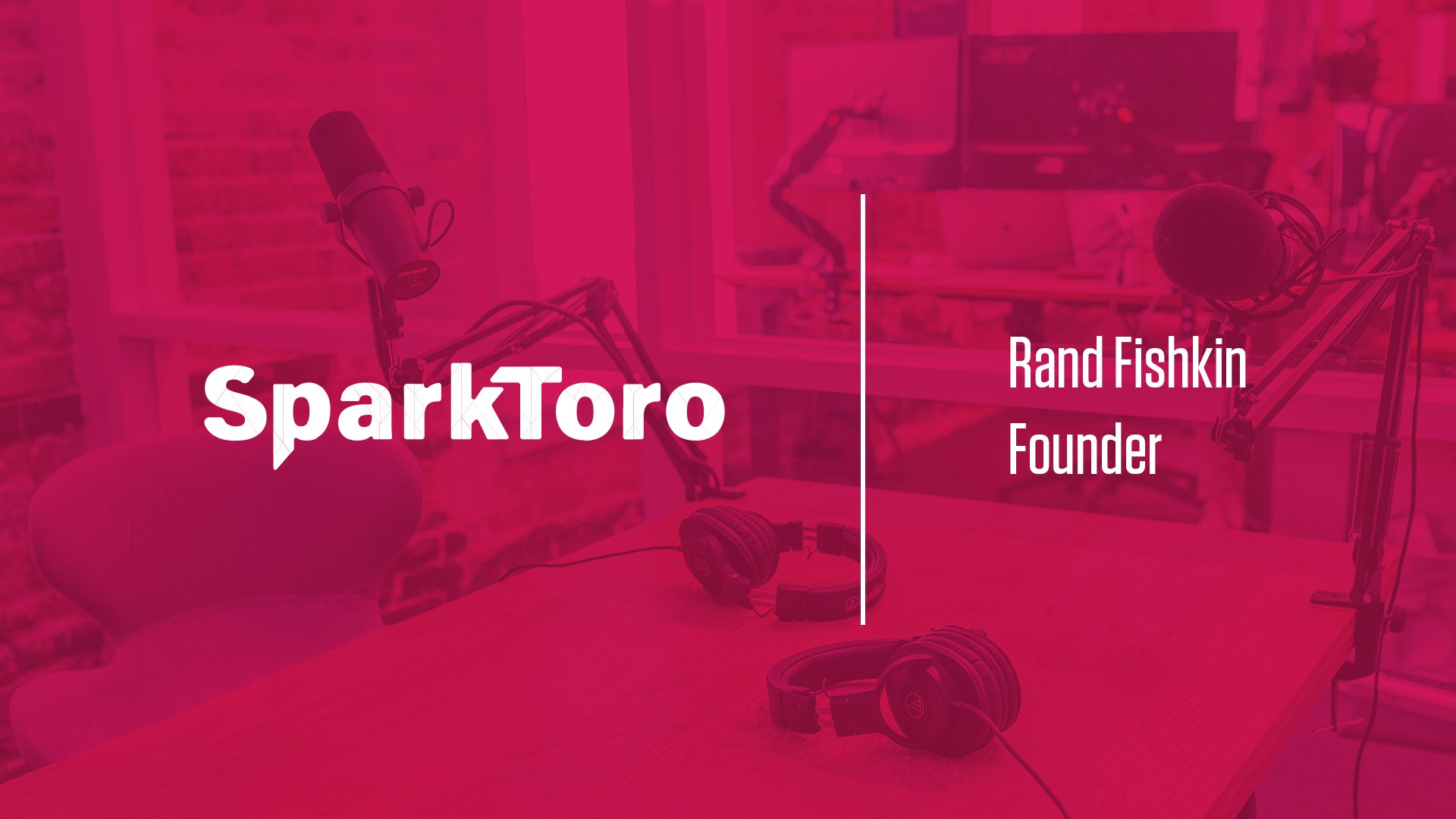
SparkToro can tell you those kinds of things, and that is obviously outside of the world of search marketing, but still very much in the world of marketing and market research. But rather than doing it through surveys and interviews, which is kind of the classic process that most folks use, SparkToro collects tens of millions of social and web profiles and then aggregates those and anonymizes them, so there’s no personally identifiable information. Then basically gives you the passively collected broad behavior of whichever group you’re searching for.
So in the case of oncologists, we just look for people who said I’m an oncologist in their LinkedIn job title or their Twitter bio, or their Instagram bio. Instagram a little bit less so, but maybe their Facebook profile or something. Then we’d say, oh okay, here’s the behavior of these 17,512 oncologists that we found that match your search criteria and what they do online, what they read, watch, listen to, follow, pay attention to, all that kind of stuff.
In the middle of those two companies, I wrote … Well, while I was still at Moz, I wrote and published a book that a lot of people are familiar with called Lost and Founder.
TS: I read it, by the way. Fantastic book.
RF: Oh, thanks man. Yeah, I appreciate it. Pre-pandemic, I did a lot of speaking and events, so a lot of folks know me from kind of stages all over the place, and a video series called Whiteboard Friday that I did at Moz. That’s most of my professional career.
TS: Okay, excellent. Yeah, Whiteboard Fridays, what a fantastic idea. I’ve watched many, many of those. Those were fantastic.
RF: Tom, I have a whiteboard in this shed that I’m in outback of my house. It’s over that way. You can’t quite see it in the frame, but I really want to get it working and I cannot get that studio effect that I had at Moz. Moz had a lower level studio with the lighting perfect and all the sound stuff. Oh man, I’m trying to replicate that at home.
TS: I think that’s a great idea. If you can get it to work for SparkToro, it’s dynamite. Because I know that you’re doing a lot of promotional videos right now, walking people through different aspects of the product. I’ll tell you Rand, those are awesome because sometimes I’m surprised with what you can do. I thought that I was pretty good at it, but then I’ll watch a video of yours and I’ll be like, wow, that’s an awesome idea.
RF: It’s funny because it’s such a simple product. It’s like, oh okay, I search for an audience and there’s a few tabs of information about that audience. I think that it’s really in the conception of how do I solve problems with it and which problems can I solve with it, and how.
TS: Yes.
RF: So every time I talk to someone like yourself or folks who are running companies or running marketing for their companies, they have unique challenges and problems and they usually need some portion of the data that SparkToro has. Helping those folks solve problems with SparkToro and illustrating that has been really fun. It’s a big change, Tom. I don’t know if you remember at Moz, but all my years there I almost never promoted the product.
Literally, you probably can’t find a video of me promoting Moz the software. I was promoting SEO, the idea, the idea of doing search engine optimization. With SparkToro it’s been really different. I think just because getting your head around audience research… maybe I’m a little less shy now, a little less embarrassed.
TS: It is a great concept that I think a lot of digital marketers are not tapping into yet, which is not only looking at search volumes and search behavior, but also where are people going on YouTube and what are they watching on YouTube? What are the specific channels that they like the most and they engage with the most? The same across the digital landscape. It’s adding an entirely new layer of value to audience research that we’re doing for clients that’s just invaluable.
We can look at the digital body language and the digital behavior of audiences in a more holistic way.
RF: Yeah. One of the things that’s really interesting to me has just been, especially in B2B, which is most of the listeners here. Many times what we assume happens, especially with a search marketing lens on, is that, oh customer has a problem, so they go to Google and they search for solutions to that problem. Then if we rank well, they’ll find us and potentially choose our solution. That’s just not how most marketing works. Sometimes that does happen. Sometimes that’s a real thing, but so much more often what happens is they have some unrelated query. They search for something, they find media sources and industry publications, and blogs and websites, and social account that they follow, and podcasts that they listen to, and webinars they attend.
They get information from all those places and it spurs ideas. Those ideas are what create the search demand. So someone is listening to one of your podcasts and they hear this amazing tactic about email automation, and they’re like, oh yeah, I should look into my email automation settings and how I can personalize that to all my different target audiences, and da da da. Okay, then they find themselves on some website and then they subscribe to that website, and then that website mentions some product or tool, and then they go check that out.
I think the problem is none of that stuff is in Google’s interest to help you measure.
Google doesn’t want to tell you, long before anyone ever searched for your brand, all these other things happened in their journey. That is not the incentive that Google has. Google’s incentive is to be like, oh well someone searched for your brand and, if you didn’t bid on it, one of your competitors might have bid on it, so you should pay more to us, Google.
TS: Absolutely. So let me ask you a little bit more about functionality of the product. So two of the things which I think are fantastic features, which perhaps some of the audience or some of your users might not know, is customized lists and customized audiences. So can you speak to those two specifically?
RF: Sure. Yeah. So a ton of the sort of use of SparkToro, but I would say the more heavy users, sophisticated users, is essentially they go into the product. They search for audiences that they’re trying to reach or they want to get in front of. That could be their target customers or their competitor’s audiences, or maybe it’s a job title or role that their product serves. Maybe it’s just an interest category. People use a particular hashtag online, whatever it is. Then they will, from those audiences, take away data like here’s the YouTube channels that they pay attention to. Okay, boom, boom, boom. I want to click, click, click, click, check mark all the YouTube channels that are relevant to what I’m doing, and I’m going to add those to a list.
Then they followup in some way. The follow up, SparkToro is not particular about. You’re just essentially creating a list in there, and what SparkToro does for you is make that list easy to access, easy to export, add contact data to it. We have a partnership with Hunter.io that feeds in email addresses and stuff. So then you could conceivably do … I think with YouTube channels, it’s usually one of three things. It’s I’m going to go into my Google display network or YouTube advertising system and I’m going to say, I want to advertise, do my pre role video ad on this channel or against audiences like this because I know that these audiences have high affinity with the people I want to reach.
If I see that 24% of oncologists in the UK, and I have my new medical imagine device, that’s my crew, that’s who I want to be in front of. The second thing is often I want to pitch those sharks. So Tom runs this great B2B marketing podcast. Well I sell to B2B marketers. I’m going to email Tom and maybe get an introduction to him through LinkedIn or whatever. I think … I can’t remember how we got connected. I think you reached out to me, right?
TS: We originally connected years and years ago when I interviewed you for my book, Rethink Your Marketing.
RF: Yes, yes. So, we had a previous existing connection. Oftentimes, you’ll find this. If you’ve got a network of some kind, one of the things that I use in SparkToro a lot is the LinkedIn profile. So it will show me this YouTube channel is this person. Here’s the host. I’ll search for their LinkedIn. Boom. Okay, who do I know who knows them? Oh, I know this person. Hey, can I get an intro? That works really, really well.
Then the third option is doing some sort of co marketing or directly sponsored advertising. So you reach out to the host and be like, hey, can we pay to get our product featured, or would you do a product review, or whatever, a product tear down of us, that kind of stuff. That can work just as well. So all of those followup actions stem from I go into SparkToro, I find the whatever it is … it could be podcasts maybe that you’re looking at sponsoring or advertising against, or trying to pitch to be on. It could be websites, it could be social accounts, whatever it is.
Then you add those to your list and you go from there. There’s also a bunch of content marketers and search marketers who use the text insights. So oh, got it, oncologist in the UK are talking about clinical trials for some new drug. Okay, I’m going to go look at maybe their search volume for those keywords. Maybe I should be producing some content, maybe I should be in some of those social conversations. Maybe there’s a hashtag around it and I should have an alert around that. Whatever it is.
TS: I think that it’s really easy for a user to just start exploring and find more and more ways to use the data. For example, we do a lot of SEO, we do a lot of content development, a lot of content marketing, and a lot of organic growth measures. So, it’s interesting for us, not only looking at the search terms, or, say, who visits the main competitor’s website. But then, for example, going into SparkToro and seeing, okay what are the most popular YouTube channels for that term or that phrase, or that competitor’s audience, and then seeing what are they talking about.
So, it’s not so much about search volume per se, but what are the topics? What are the challenges that they’re dealing with and why is it so engaging? Why do they have such high engagement on their YouTube channel? Deciphering that just gives us new insight into how to target their audience beyond search volume.
RF: I think that’s super smart. I think a lot of marketers don’t realize that their competition isn’t just people who are selling a similar product or solving a similar problem. It is also people with whom they are competing with for attention. That can be media outlets and industry publications, and news sources, and influential people on YouTube or with influential podcasts, or with social presences on Twitter and LinkedIn, especially in B2B those are the big two.
My sense is a lot of times that gets ignored in favor of here’s the search volume for all these keywords. Let’s go do everything based on that.
Even if search is all you care about, one of the smartest things that you can do is recognize and invest in content around a topic before it becomes popular in search. Usually that happens in social. Usually it’s a topic is discussed a bunch through whatever, there’s some news story about it, there’s some new player in the field. Someone got funding, someone got an IPO, someone invented a new product. So it starts to get conversation online. In B2B, usually that’s Twitter and LinkedIn. It could be a little bit Facebook and Instagram. Maybe depending on the sphere, it could be Reddit a little bit.
But those kinds of places that SparkToro gets data from and then you see that turn into, over months and years, search volume and branded search for particular people that they think are solving that problem.
TS: Yeah, absolutely.
RF: If you can play early, you can have a competitive advantage.
TS: Yeah, I think that is a great insight, and it’s not talked about enough. So, Rand, tell me, what are some of the most innovative ways that you’re seeing people use SparkToro?
RF: I’ll tell you one of my favorite stories. It’s not B2B. Well, actually maybe it is a little bit. I can’t reveal exactly the television show, but basically there was this television show that was on one of the major traditional networks. Maybe you’ve heard of the show. It’s not super popular. I had heard of it. It’s sort of a niche show a little bit, but fictional series, live action. The audience for it was very, very passionate, but relatively small. The show got canceled and this branding digital strategy agency that works with a lot of Hollywood Studios and production companies, and people like Netflix and Hulu, and HBO Max and that whole world, signed up for SparkToro and dropped us an email and were like, hey, we are trying to help the producers of this show save the show from being canceled.
Basically, we want to use SparkToro to help pitch it to other networks that will pick it up because they want to reach the audience that the TV program reaches.
TS: Brilliant.
RF: Isn’t that amazing?
TS: That’s amazing.
RF: Super cool use case. So they basically took a bunch of data around people who were using … they searched for things like people who were using the hashtag of the TV program, people who were following the primary actors involved in it. There were some social accounts that were sort of tied to the TV show. There were some words and phrase specific to the name of the show or names of characters. They put together this big sort of report for their pitches to the other studios.
Hey Netflix, we want you to take a look at this show. Here’s the audience it reaches. You can see the engagement levels and we can show you that here’s sort of this audience compared against the audiences for your other shows that target this demographic, and the overlap is small. So this is a new potential audience for you. It will help you, Hulu, compete against Netflix and HBO Max and Amazon Prime and whatever. That pitch, my understanding is it’s successful and the show is now in production for a season that’s coming out. I don’t know exactly when, but super cool.
TS: That’s awesome. That is super cool. It really is.
RF: Yeah. So just kind of amazing. It’s a very strategic research based use case, versus a hyper tactical, let me go find a podcast to pitch for my B2B software, but I love that kind of creativity. When I saw those guys doing it, I talked to one of the guys behind it. A very, very smart character. I was like, oh I wish I could hire you.
TS: That’s awesome.
RF: It’s just this partner and they run this strategy agency, and they kick butt.
TS: I want to turn the questions a little bit more personal now.
RF: Yeah.
TS: Rand, I’d love to hear from you what’s the difference in your experience growing Moz versus trying to grow SparkToro now?
RF: Ooh, so channels and tactics is a huge one, as is… Actually, I think strategy is really similar. So I kind of get to play on some strengths that I’ve already got. Okay, well how do we build up the world of SEO and make that feel trustworthy. The answer with Moz was a lot of transparency, a lot of transparency, a lot of experimentation, a lot of networking and making friendships and relationships, a lot of content, all those kinds of things. I think with SEO, I was always one third trying to build the brand of Moz and two thirds trying to build the brand of SEO. Just hey, you people out there should think Google is a real thing. It is a real thing, I promise you.
With SparkToro, that is similar, trying to convince people that, hey audience research is a thing. There’s all these possibilities. Whether you use SparkToro or not, knowing things about the audience that you’re reaching and being able to make smart decisions based on your understanding of them, having some data behind that, wow that’s a win. Then tactically, it could not be more different. So Moz was essentially very much built on the classic SEO content fly wall. I maybe have a conversation with someone like yourself, Tom, and you and I talk about a particularly tactic. SEO for B2B challenger brands. Okay, gosh, I wonder if there’s … Let me go to Google and sort of search around here. Let me go to my keyword tools and see, okay, yeah, the Moz keyword tool says a few hundred.
All right, I’m going to make a Whiteboard Friday video about SEO for B2B challenger brands. How do you win versus competitors in B2B, etc. etc. I’ll make that video, we’ll produce a transcript for it, we’ll try and get links to it, we’ll try and rank for it, and then hopefully when we hit publish, lots of people see that video, da, da, da. You kind of get that flywheel going as you build an audience. More people consume the content, more people subscribe. Then next time you produce a piece of content, it does a little bit better because there’s more subscribers, all that.
SparkToro, very little content. I think I’m maybe going to get out 30 blog posts this year total on the SparkToro blog. Most of what I do in terms of marketing, for channels and tactics, is really find sources of influence that already reach marketers and market researchers, and then go have conversations, find ways to work together with them to talk about SparkToro, to talk about audience research, and then have them present that to their audiences. The reason for that is nobody searches for what we do. There’s no search volume.
You can barely find a relevant keyword. The closest thing you’ve got is maybe persona building, but most of the people who build personas are thinking about it in a very different way than from a research perspective. They want whatever it is, top notch tom, and he has three dogs and two kids, whatever it is, and he’s our target customer. It’s very non data driven and very survey and interview based and that kind of thing. I personally like data driven personas, but getting that to take off is its own challenge. So yeah, with SparkToro, it’s actually doing a lot of the things SparkToro helps you with.
Let me go find the sources of influence for the people that we need to reach and then let me go tell stories and talk about why it’s interesting and try and reach them in the places that they already pay attention. I think that’s what a lot of brands who are building a new category have to do.
TS: All right, so this is probably the most important question I’m going to ask you today. Can you explain to our listeners why you were on the Oprah Winfrey Show?
RF: Oh, man. This is a long time ago, Tom. What’s that, 2008, I think.
TS: It’s such a great story. You have to tell it!
RF: All right. So let’s see… I’m going to try and tell the medium length version so it’s not too long of a story, but let’s just say that there’s this guy who had been reading my blog, the Moz blog for a long time.
For folks who don’t know, in the early years especially, actually even in the later years, the Moz blog was both the company’s blog and Rand’s personal blog. It was the combination and there was a lot of the two mixed in there. This guy from Nashville, Tennessee who had started a website called My Super Proposal. So this guy was basically planning to raise money, crowdfund a raise of money to buy a Superbowl ad so that he could propose to his partner.
I don’t know… he was in the marketing world somehow, but basically what happened is he had raised maybe $25,000 or something toward a two million dollar ad buy, and his partner found out about the project somehow and was basically like, I do not want that. That is not… please don’t do that. So he sent me an email and was like, hey Rand, I see that you’ve been writing about … At the time, I always referred to Geraldine on the blog as mystery guest. So I see you’ve been writing about mystery guest. Would you want to take over this website and maybe work on it? I was like, that could be kind of a fun side project. Yeah, I’ve been thinking about ways to propose to Geraldine. This sounds cute. Let’s do it.
So, I took it over. It started getting some media buzz and coverage. It was just organically getting picked up. All these radio shows. I’d do early morning calls with some radio show on the east coast about this. They’d modify my voice so you couldn’t tell who it was, all that kind of stuff. I think Entertainment Tonight, some show like that, flew out to Seattle, met me at Seatech Airport, like at a motel there. They cleared a bunch of space and they darkened my face. They had this whole episode about the guy who’s trying to raise money for the Superbowl proposal.
Anyway, the website got a bunch of donations. I don’t remember what it was. Maybe it was $75,000 in total. Then Target, the retailer, called up and was like, hey… Well, I think they emailed, but they were basically like, hey, we’d be interested in whoever this is behind this website. We’d be interested in talking to you more. They talked to me, they flew me out to where was that? Minneapolis in the middle of winter. It was like January. It was so freaking cold, just crazy. Drove me to some studio. They had their whole … it’s like the super white set. I don’t know if you remember all the Target ads, but completely white set, one red chair. They had me sit in the chair with a bunch of different outfits on and essentially propose to Geraldine for hours, line nine hours.
No guy has ever proposed to his partner as many times as I did. They were basically like, we’ll sponsor this Superbowl ad. So a week before the actual Superbowl that year, they pulled out. They were like, nope, we changed our mind, we don’t want to do it. Too brand risky. Blah, blah, blah. Honestly, probably the best thing that could have ever happened because wouldn’t it be so horrible now to be a pop culture footnote like, oh hey, that’s that guy from… yeah, that’d be terrible.
All right, we’re getting to the end of the story here. I ended up just buying a local TV ad during Geraldine’s favorite TV show at the time, Veronica Mars. Thankfully this is before … this is while they were still advertising, running concurrently with shows. So we’re watching broadcast television, so she wasn’t able to just watch the show on Netflix or something like that. So we hid a camera in the apartment and proposed. The video of her freaking out, you can find it on YouTube. It’s pretty cute. But Oprah’s people, whatever, they saw the show and they were like, hey, would you come on our program for the Valentines Day episode? The two of you because you seem adorable.
I was like, well, gosh, I don’t really know. Maybe how about you fly us to Chicago for an extra day because we’ve always wanted to go to the Chicago Art Museum. They agreed to it so we flew out to Chicago and we were on the show and went on stage and hung out with Oprah. I think I had two words on the whole episode. Geraldine did most of the talking. It was an interesting experience, for sure.
TS: What a great story. I love that story. So, thanks for taking the time to walk our listeners through that because I think it’s just so special.
RF: It was a fun experience.
TS: So Rand, let’s say that our listeners want to find you or find SparkToro. Where should they go?
RF: Yeah, so if you go to SparkToro.com, the nice thing is we don’t do a free trial, but we have a forever free account. So you can just run five searches a month for free, forever. It will keep getting topped up, so you can play around with the product to see if it helps you. Lots of people just use the free version. They don’t even need the paid version, so you can check that out. Yeah, if you want to follow the stuff that I’m talking about, which is usually mostly marketing and tech related, I am @RandFish on Twitter. That’s where I’m most active and also fairly active on LinkedIn.
TS: Excellent. Excellent. All right, thanks so much for joining us today. I love SparkToro. I find so much value in it. I hope that our listeners check it out and sign up for an account because it really is a great tool and I’m sure you’re going to be very, very successful with it.
RF: We shall see. Thank you so much, Tom. I really appreciate you having me.
TS: Thanks so much, Rand.

